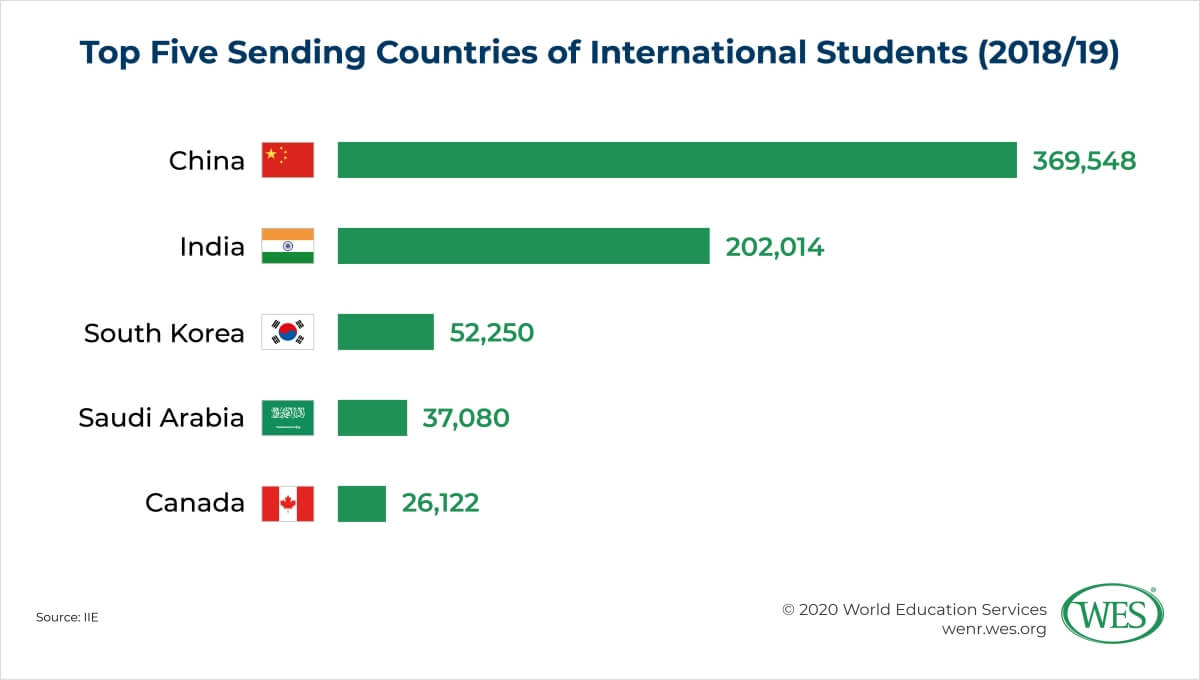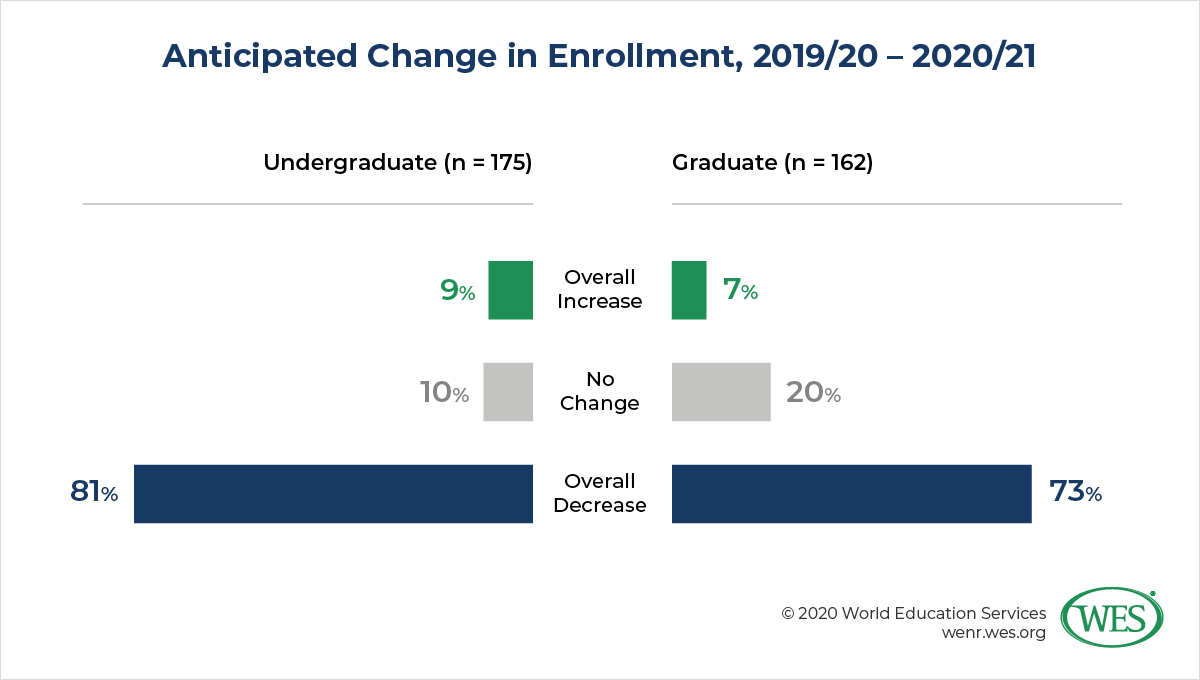Kelly Acheson, Communications Specialist, WES
Persistent upheaval and unpredictable change have come to define international education in 2020, leaving both students and higher education institutions uncertain about the coming year. A dizzying succession of developments—unexpected policy changes, surges in coronavirus, inconsistent messaging from government officials, and international border closures—have worked together to derail international education in the United States and point to a turbulent year ahead.
International students are critical to the U.S. economy, however, in terms of both their talent and their spending. Staying abreast of the latest developments along with sharing insights on how best to support international students is critical to international education experts, organizations, and academic institutions.
On July 29, World Education Services (WES) hosted a Twitter chat [2] to explore the issues and trends currently shaping international higher education in the U.S. Using the hashtag #IntlEdNow [3], participants discussed how a variety of factors—from COVID-19 to the U.S. political and regulatory climate—have changed prospective international students’ perceptions of the U.S. The chat also explored what can be done to support and advocate on behalf of international students now and in the future.
International students will be essential to the nation’s recovery. They play a vital role in the U.S. economy and society, and in the country’s colleges and universities. The U.S. Department of Commerce estimates [4] that international students contributed around $45 billion to the economy and supported roughly 455,000 jobs during the 2017/18 academic year. Former international students have also played an outsize role in maintaining the country’s entrepreneurial edge. According to an October 2018 National Foundation for American Policy (NFAP) brief [5], almost a quarter of U.S. start-ups valued at $1 billion or more were founded by former international students.
Although the tuition fees and entrepreneurial contributions of international students will be critical as the U.S. economy recovers, participants were clear-eyed about the challenges that lie ahead. Some of the top takeaways from the Twitter chat focused on the macro-factors that may influence student plans for 2021/22 and beyond:
- International students face many barriers to studying in, working in, and contributing to the U.S. Meaningful visa policy reform is needed to remove these obstacles.
A8: #Intlstudents [6] face unnecessary barriers to study and contribute to the United States. We need meaningful immigration reform to remove these burdens, such as creating open-work visas for recent graduates and making more skilled visas available each year #IntEdNow [7] 1/2 https://t.co/p1DzSdh6Js [8]
— New American Economy (@NewAmericanEcon) July 29, 2020 [9]
A8 For Fall 2020, we can expedite the visa process as a form of adaptation to this new world we are currently living in. One recent victory for #intled [10] saw #intlstudent [11] travel deemed essential.
Now, visa processing needs to become streamlined so that they can actually get here
— One To World (@OneToWorldInc) July 29, 2020 [12]
- The outcome of the presidential election in November will be key to the future of international education in the U.S.
A8. Sorry I have 4!. One, I hate to say it but the U.S. Presidential election. It seems clear that a change in U.S. leadership is one of the few events big enough to create confidence that the country is open and welcoming to outsiders again. #IntlEdNow [13] https://t.co/dRjWF6mTI5 [14]
— Jessica B Sandberg (@JessBSandberg) July 29, 2020 [15]
Vote in November. https://t.co/MHZ3y28ysy [16]
— NAFSA (@NAFSA) July 29, 2020 [17]
A8 The single biggest opportunity to help preserve the reputation of the U.S as a welcoming destination for #intlstudents [18] is to elect 46 to the Oval on Nov 3rd! #IntlEdNow [13] https://t.co/RfLLna9WDm [19]
— David Comp (@DavidComp) July 29, 2020 [20]
But domestic issues aren’t the only danger to international student flows. Growing tensions between the U.S. and China threaten to disrupt mobility from the largest source country of international students in the U.S. Executive orders have targeted Chinese students and organizations by rescinding the visas of students affiliated with China’s military establishment [21], suspending the Fulbright exchange program with China [22], and, most recently, by banning WeChat [23], a popular app students from China use to stay in touch with their families back home.
Our Twitter chat participants noted the significance of these tensions to Chinese international students:
- Deteriorating relations between the U.S. and China have had a notable impact on international students’ perceptions of the U.S. Heightened tensions between the two countries have put international students on the front lines of this escalating political battle.
A2 China is a top exporter of international students to the US. However, as US-China relations continue to deteriorate, #intlstudents [18] and #intled [10] are being put at the frontlines of this political battle. #IntlEdNow [13]
Source: https://t.co/b9CCsO3DKY [25] https://t.co/7hnnyQWc85 [26]
— One To World (@OneToWorldInc) July 29, 2020 [27]
A2: (1/3) Where to start??? – concerns of student safety, seemingly random travel bans, inconsistent & changing visa policies, disparaging lang from national leaders toward foreigners, lack of train and retain policies, heightened tensions with China, health crisis….#IntelEdNow [28] https://t.co/Abspfcqo91 [29]
— Jason E. Lane (@ProfJasonLane) July 29, 2020 [30]
Yes, U.S.-China relations are a very important part of this discussion. In addition to the politics, there is the stark contrast in COVID management at present. China has reopened. The U.S. is struggling with widespread transmission. #IntlEdNow [13]
— Jessica B Sandberg (@JessBSandberg) July 29, 2020 [31]
These factors, along with a disjointed U.S. response to the COVID-19 pandemic, international travel restrictions, limited visa processing services, and restrictive policy changes, threaten to drastically lower international enrollment. WES research [32] finds that roughly three-fourths of international education professionals at U.S. colleges and universities expect international student enrollment to decline in the 2020/21 academic year. Anticipating other COVID-19-related challenges along with revenue losses from lower international enrollment—international students contribute an estimated $20 billion in tuition and other fees [33] each year—institutions are implementing drastic cost-saving measures, including laying off tenured faculty [34].
The good news is the appeal of a U.S. education remains strong internationally. And despite recent visa policy changes, the U.S. political climate may not be entirely inhospitable to positive student visa reform. Participants expressed several reasons for optimism:
- Despite the odds, many international students still want to pursue a U.S. education.
A1 I don’t think the perception of the U.S. as a top destination has changed for #intlstudents [18] in terms of academics and the value of a degree from a U.S. college or university. #IntlEdNow [13] 1/3 https://t.co/EP4Z3jTPxO [36]
— David Comp (@DavidComp) July 29, 2020 [37]
A8: The messages that colleges, communities, and elected officials send is important. But international students themselves are an important voice. And despite all the odds, many of them still believe in and want an American education #intlednow [38]
— Karin Fischer (@karinfischer) July 29, 2020 [39]
- There is bipartisan support in Congress for OPT and CPT, which enable international students to work and contribute to the U.S. during and after their studies.
A6. On a related note, take notice of the 21 Republicans in the House that advocated for #OPT [40] with @StateDept [41] and @DHSgov [42] last month. We need to urge these champions for #intlstudents [18] and #OPT [40] to stay engaged. More threats loom. https://t.co/uFi0Xd1qhO [43]
— NAFSA (@NAFSA) July 29, 2020 [44]
But action is still needed. Twitter chat participants agreed that the challenges require a coordinated response on the part of international education organizations, higher education institutions, and employers. Recent events neatly illustrate the effectiveness of that strategy. A lawsuit filed by Harvard University and the Massachusetts Institute of Technology was supported by hundreds of academic institutions [45] and international education organizations across the country, as well as some of the largest technology companies [46] in the U.S., such as Google. The lawsuit challenged the Trump administration’s July 6 directive requiring international students to leave the country if their coursework would be entirely online. The coordinated opposition prompted the U.S. Department of Homeland Security to partially rescind the order, a move that mitigated its impact on international students. A chorus of voices laid out what needs to be done:
- Advocacy via coalition-building is vital. Higher education institutions and like-minded organizations must come together to represent international students’ needs and help elected officials and the public recognize the value that international students add to the nation’s economy, international relations, and society. There is also a greater need for higher education institutions to collaborate with companies and start-ups in Silicon Valley to support OPT opportunities for international students.
A6 One of the strongest forms of advocacy is coalition-building. #Intlstudents [6] are valuable to a wide range of institutions and when these orgs come together to represent intl student needs, they are compelling & strong advocates. #IntlEdNow [13] https://t.co/YBoqkpw2Bl [47]
— One To World (@OneToWorldInc) July 29, 2020 [48]
A6: (2/2/) I envision more collaboration between the #highered [49] sector and industries supportive of OPT and #intlstudents [18], such as those in Silicon Valley, to advocate more for these programs. #IntlEdNow [13]
— Bryce Loo (@BryceLoo) July 29, 2020 [50]
A6 I think institutions & employers need 2 do a better job in our advocacy of #OPT [40] & #CPT [51] as well as #AT [52] for our #J1 [53] #intlstudents [18] & scholars. These are also factors in the decision making process & perception of U.S. by #intlstudents [18] (see Q2) #IntlEdNow [13] 1/2 https://t.co/A7xhtwGngJ [54]
— David Comp (@DavidComp) July 29, 2020 [55]
Finally, as others have said, forming alliances for cross-industry advocacy to support #intled [10] and say #youarewelcomehere [56] at a policy level. #IntlEdNow [13]
— Jessica B Sandberg (@JessBSandberg) July 29, 2020 [57]
A8 We must help our fellow Americans & elected officials recognize the value that #intlstudents [18] add to our economy, international relations & our society – and treat them accordingly. (1/3) https://t.co/ApBulKSiTK [58]
— One To World (@OneToWorldInc) July 29, 2020 [59]
A7: If your #highered [49] 🍎 institution isn’t already a member of @PresImmAlliance [60], join our alliance of nearly 500 members in advocating for #immigrant [61] and #intlstudents [18]. #IntlEdNow [13] https://t.co/CskzIJ2Mko [62] https://t.co/FgKQIu1IX3 [63]
— Presidents’ Alliance on Higher Ed & Immigration (@PresImmAlliance) July 29, 2020 [64]
With the start of the fall semester rapidly approaching, collaboration and advocacy are more urgent than ever. Such collaboration will require up-to-date insight into the most important developments impacting international education in the U.S. We look forward to continuing that conversation with international students and their advocates.
We acknowledge the following organizations and higher education institutions which participated in our recent Twitter chat and helped to make it a success:
Participating organizations:
- IDP Connect
- Institute of International Education
- NAFSA: Association of International Educators
- New American Economy
- One To World
- Presidents’ Alliance on Higher Education and Immigration
- Whitworth International Admissions (at Whitworth University)
Individuals from the following organizations and higher education institutions also participated:
- The Chronicle of Higher Education
- College Board
- Columbia College Chicago
- Consortium for North American Higher Education Collaboration
- Council of Graduate Schools
- Duke Kunshan University
- Milken Institute
- State University of New York at Albany
- University of California, Santa Cruz
- University of Vermont
- University of Virginia
The views and opinions expressed in this article are those of the author(s) and do not necessarily reflect the official policy or position of World Education Services (WES).



